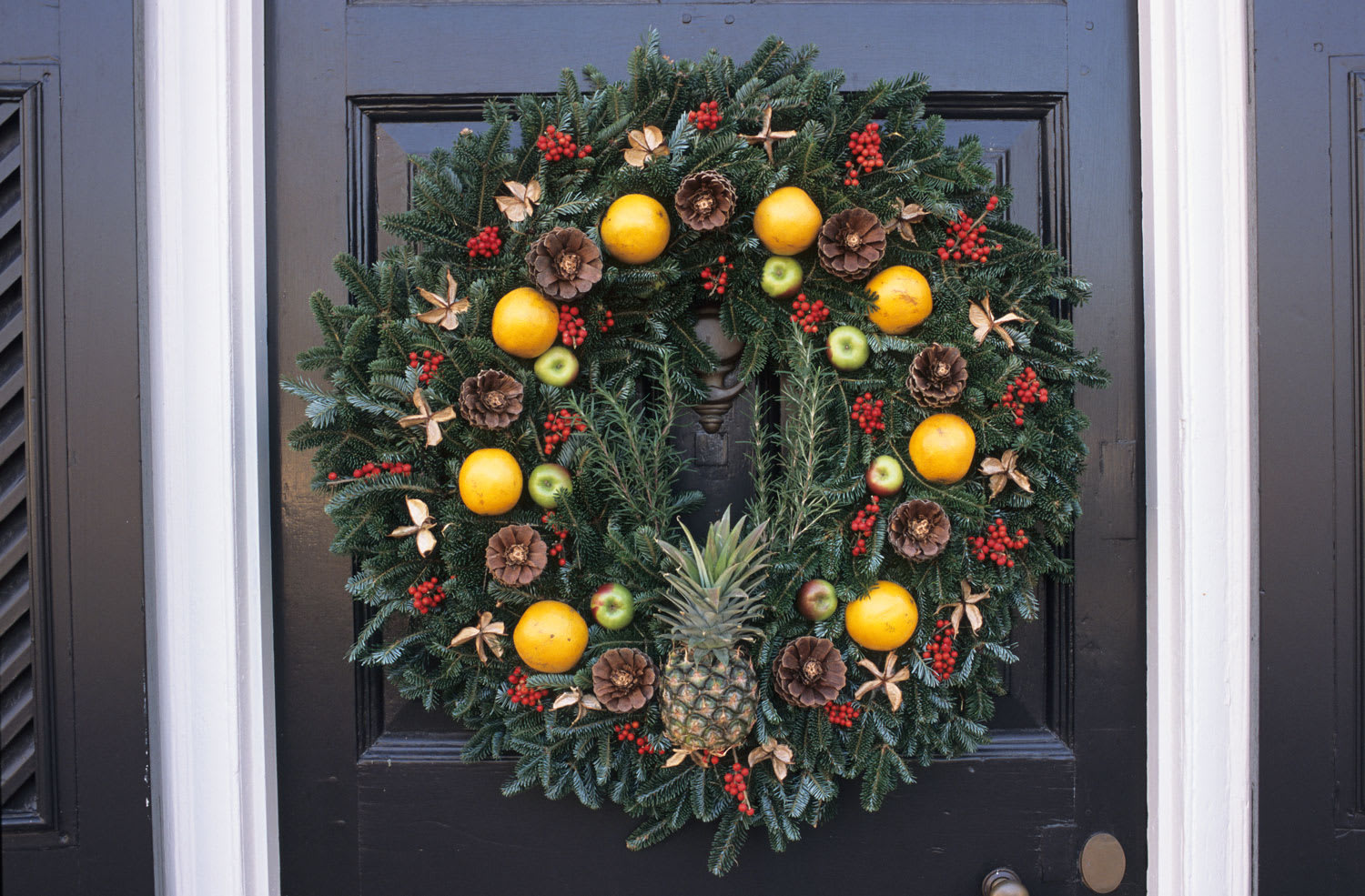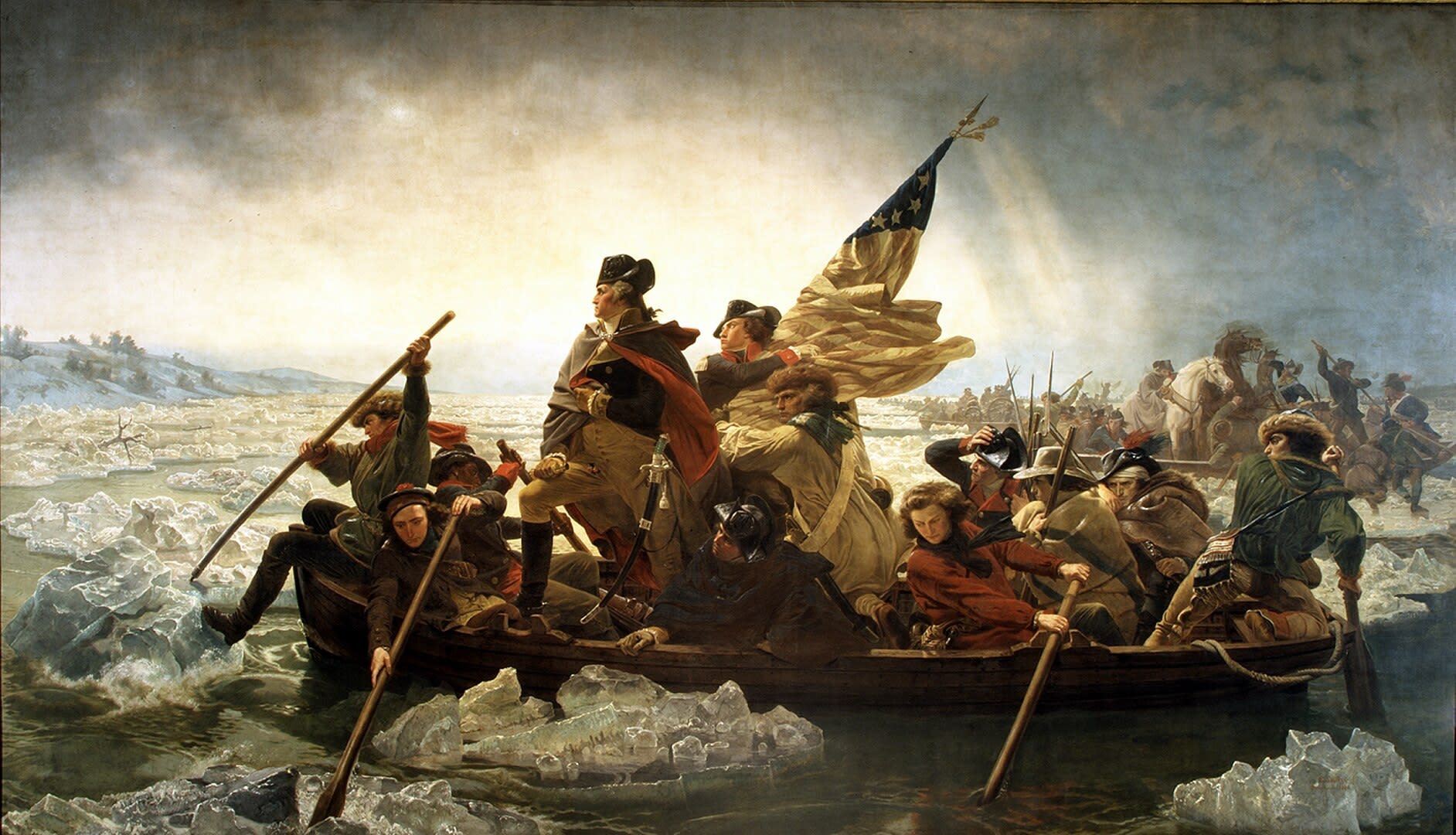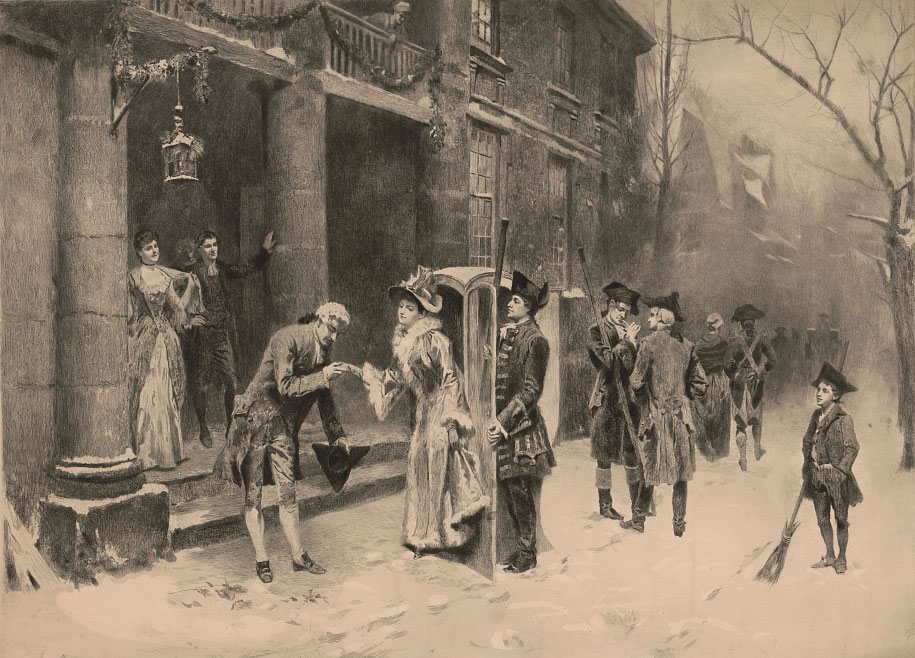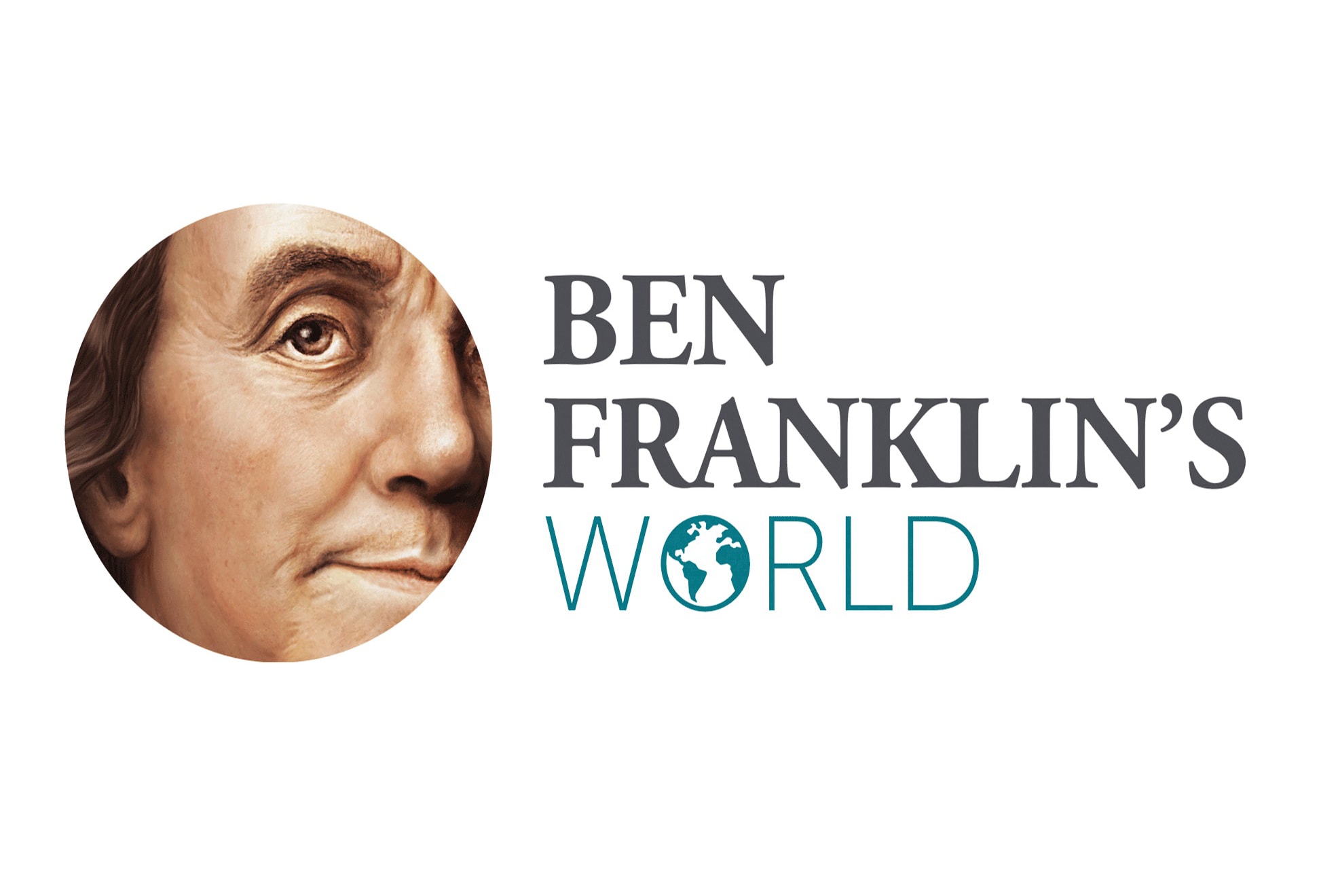Christmas stirs warm nostalgia on cold nights. Envisioning a simple, sentimental past, Americans have developed many misconceptions about the holiday’s beginnings in North America. Below are a dozen of the most common myths.
As you will discover, Christmas in colonial and revolutionary America was not the wholesome, family-oriented holiday that Americans celebrate today. In the eighteenth century, Christmas was often rowdy, drunken, wild, and dangerous.
You could also read this list as a guide to celebrating Christmas like someone in eighteenth-century America. But be careful not to be too authentic. You could get arrested.

Myth 1: Christmas was quiet and peaceful.
“I was waked up this morning,” wrote Philip Fithian, a visitor in a Virginia plantation, “by Guns fired all round the House.”1 For Fithian, who may have been unfamiliar with the holiday tradition of firing guns at Christmas, this was a startling way for Christmas to begin. But men throughout the colonies made a habit of firing guns at Christmas, often to the chagrin of authorities who worried about the dangers.2
Like the mornings, there were few silent nights at Christmas. The respectable folks sang carols, played games, performed plays, and danced to music. In places like Virginia, dancing in the summer could be unpleasantly hot, making Christmas a perfect time to plan a ball. Skilled Black musicians often performed for such occasions.3 One wealthy plantation family hired fiddlers, a jester, a tight-rope walker, and an acrobat for a Christmas celebration.4
For those who couldn’t afford such extravagance, Christmas was often a time for excessive drinking. Depending on the household, people might consume brandy, rum, wine, gin, whiskey, beer, cider, cordials, or punch.5 One visitor to a Virginia gentry home recalled that there was “good wine and all kinds of beverages, so there was a good deal of carousing.”6 A New York newspaper complained about Christmas carousers disturbing “those citizens who would rather sleep than get drunk.”7

Myth 2: Everyone celebrated Christmas.
American settlers disagreed about Christmas. Virginia’s eastern, Anglican communities like Williamsburg enjoyed celebrating the holiday. But it wasn’t an important event in many Scots-Irish, Presbyterian frontier communities.8 Philip Fithian saw both. Having been woken by gunfire at a Tidewater plantation, he was shocked to wake up in a Presbyterian community to silence. In his diary, he wrote, “Not a Gun is heard – Not a Shout – No company or Cabal assembled – To Day is like other Days.”9
Other Protestant groups, including Quakers and Puritans, disliked Christmas. On Christmas 1795, Quaker Elizabeth Drinker wrote in her diary, “Called Christmass day: many attend religeously to this day, others spend it in riot and dissipation.” She noted that Quakers like her “make no more account of it than any other day.”10
Many early Puritan New Englanders saw Christmas as an un-Biblical excuse for laziness and disorder. In 1659, the Massachusetts General Court made it a criminal offense to celebrate Christmas. But some colonists celebrated anyway. By the late eighteenth century, New Englanders widely celebrated Christmas, even as some of the clergy remained suspicious of it.11

Myth 3: Christmas was a single day.
When we start to hear Mariah Carey’s voice blaring from grocery store speakers in October, some of us wistfully imagine a time when Christmas was a day, rather than a season.
But in eighteenth-century America, Christmas took up a big chunk of the calendar. Virginia Anglicans celebrated from just before Christmas until Twelfth Night, on the evening of January 5. Some extended the season into February. A Virginia almanac for 1765 joked:
When New Year’s Day is past and gone,
Christmas is with some people done,
But further some will it extend,
And at Twelfth Day their Christmas end.
Some people stretch it further yet,
At Candlemas [Feb. 2] they finish it.
The gentry carry it further still
And finish it just when they will;
They drink good wine and eat good chear
And keep their Christmas all the Year.12
While the Christmas “season” now usually starts around Thanksgiving (or earlier) and ends shortly after December 25, an eighteenth-century Christmas season often began in mid-December and might carry on through January or early February.13

Myth 4: Christmas wasn’t always so materialistic.
Those who dislike the consumerism of modern Christmas celebrations might imagine that colonial Christmases were less materialistic than they are today. It’s true that family gift-giving wasn’t an essential part of the holiday prior to the nineteenth century. But for many people, Christmas was an important chance to receive money.
During the holiday, custom dictated that servants, apprentices, and enslaved people accepted tips from those whom they served. Sometimes these were called “Christmas-box” tips, for the container that traditionally stored the coins.14 Fithian recalled spending much of his Christmas morning at a Virginia plantation tipping the enslaved people.15
Peter Fleet, who was enslaved by a Boston newspaper printer, delivered the Boston Evening-Post to subscribers. He accrued a small fortune in Christmas tips from his customers. In 1743, he wrote a will dispersing his funds to his son and the other children in the household. Anticipating that his enslavers might think he “got this money by Rogu[e]ry,” he explained that he “got it honestly; by being faithful to people ever since I undertook to carry the Newspapers, Christmas-days.”16 For many apprentices and enslaved people, Christmas was the most important time of the year to receive tips.

Myth 5: Enslaved people were happiest at Christmastime.
In the nineteenth century, enslavers often described Christmas as a moment of peace and paternal benevolence. It was a way they defended slavery. It was not universally true, yet an image of enslaved people having the chance to celebrate the holiday has persisted.17
Christmas could be a tense time in a slave society. While some enslavers provided enslaved people with extra rations and time off during Christmas, many also feared that idle time would breed resistance.18 Colonial Virginia and South Carolina authorized Christmas slave patrols.19 Indeed, some enslaved people took advantage of unsupervised time at the holiday by emancipating themselves or fighting back against enslavers.20
Some enslaved people received no respite at Christmas. The holiday might mean more work, not less, for someone serving meals or attending to guests.21 And some enslavers refused to offer any Christmas privileges. In 1774, Virginia enslaver Landon Carter congratulated himself in his diary for “not letting my [enslaved] People keep any part of Christmas.”22
We have little first-hand testimony about the activities of those enslaved people who were allowed to celebrate Christmas. Like many others in early America, they probably observed the holiday with a mix of social events, leisure activities, and religious observances. One Presbyterian minister described a group of enslaved people in Virginia celebrating Christmas by “singing Psalms and Hymns in the evening, and again in the morning, long before the break of day.”23

Myth 6: Lavish Christmas decorations adorned homes.
In the 1930s, Colonial Williamsburg introduced holiday decorations in the Historic Area based on decorative elements available in the eighteenth century. Candles adorned windows.24 Festive wreaths with fruits like apples and pineapples hung on doors.
But there is no evidence that wreaths or candles decorated colonial homes at Christmas. In eighteenth-century Virginia, candles and fruit were precious commodities, especially during winter.25 Today, Colonial Williamsburg continues this cheerful decorative tradition each winter, even if it is a bit extravagant by eighteenth-century standards.
Though lacking exterior decorations, some eighteenth-century homes and churches decorated their interiors with evergreen tree branches at Christmas. Mistletoe, with the accompanying kissing ritual, was common as well.26

Myth 7: Christmas happened at home with family.
Christmas was a major social event in many communities, rather than something celebrated only within a family. Dancing, food, music, and games drew households together. Where snow wasn’t expected, people planned trips for Christmastime. It was also a popular time of year for weddings.27
During Christmas, according to one observer, “a universal Hospitality reigned” in Virginia: “Strangers are fought after with Greediness, as they pass the Country, to be invited.”28 One Virginia almanac shared these verses:
Christmas is come, hang on the pot,
Let spits turn round and ovens be hot
Beef, pork, and poultry now provide
To feast thy neighbours at this tide.29
It wasn’t until the middle of the nineteenth century that family celebrations at home became an indispensable part of Christmas. 30

Myth 8: Christmas wasn’t political.
Today, Christmas often gets caught up in political and cultural arguments. But that’s not new. People in the eighteenth century sometimes took advantage of the Christmas season to challenge their social superiors. Drawing on European folk traditions, Christmas was a time when people shook things up and turned the social order upside down.31
Students sometimes demanded a longer Christmas break by “barring out” their schoolmaster to prevent him from entering the schoolhouse. At William & Mary around the Christmas of 1702, the students launched a rebellion that the College’s President James Blair recounted: “I heard the School boys about 12 o’clock, a driving of great nails, to fasten & barricade the doors of the Grammar School.” He tried to force the doors open before the students “fired off 3 or 4 Pistols & hurt one of my servants.”32
A rowdy gang of Christmas revelers called the “Anticks” menaced high-society Boston in the late eighteenth century. They engaged in an aggressive form of the English tradition of mumming, in which people performed short Christmas plays in exchange for food and drink. The Anticks would invite themselves into the homes of Boston’s wealthiest families and “demean themselves with great insolence.” When they concluded their disrespectful performance, they wouldn’t take the traditional gift of food and drink. They demanded cash.33 At any other time of the year, they might have been jailed for robbery and home invasion. But at Christmas, some Americans suspended their expectations about respect for social superiors.

Myth 9: Christmas was a religious holiday celebrated in church.
Christmas brought many people in early North America into church. But not all of them. Some religious sects didn’t recognize Christmas. And in many places, church was not easily accessible. One London merchant stuck in Virginia for the holiday complained in his diary about being unable to find a “public place of worship” for Christmas services. There was a nearby church, he noted, but “there happens to be no preacher. Being Christmas Day you miss it more than common.”34
Even in places where Christmas was celebrated by a religious leader, attendance might be sparse. As one newspaper described, it was “the temples dedicated to the service of merriment, dissipation and folly” that were crowded, rather than the churches.35

Myth 10: George Washington defeated Hessian mercenaries who had been drinking to celebrate Christmas.
In the early morning of December 26, 1776, General George Washington led the Continental Army to a major victory by attacking an encampment of Hessian mercenaries at Trenton. It’s often said that these Hessian soldiers were unable to organize their defenses because they were all drunk or hung over from Christmas celebrations.36 It’s a good story.
But there is no evidence that the Hessians were drunk.37 One American soldier present that night testified in 1809 that “I did not see even a solitary drunken soldier belonging to the enemy.”38 If the Hessian troops fought poorly, it may have been because they were exhausted from a week of fighting.

Myth 11: Christmas has always been a magical time for children.
Christmas wasn’t very much fun for eighteenth-century children. Some wealthy children received gifts, such as books or candy.39 But most accounts of early Christmas celebrations don’t mention children. Many of the most widely embraced Christmas traditions—gambling, excessive drinking, shooting guns, fox hunting—were not very child friendly. Children might be allowed to participate in some adult activities, like dancing and going to church. But they had to wait until the nineteenth century for Christmas celebrations to become oriented around them. 40

Myth 12: Eighteenth-century Americans celebrated Christmas with Santa Claus and Christmas trees.
For many Americans today, it wouldn’t be Christmas without a decorative tree and a jolly man in a red suit. But these things were unknown in eighteenth-century North America.
Christmas trees first appeared in medieval Germany. And Protestant cultures in northern Europe replaced the Catholic Saint Nicholas (whose feast was celebrated in early December with gifts) with Santa-like folk characters such as Belsnickel and Sinterklaas. Some have suggested that early Dutch and German immigrants brought these practices into colonial North America. But there’s no documentation of Santa Claus or Christmas trees in North America until the early nineteenth century. 41
A German refugee named Charles Minnigerode introduced the first documented Christmas tree in Virginia in 1842. He had settled in Williamsburg as a professor at William & Mary and befriended the family of Nathaniel Beverly Tucker. At Christmas, he delighted the Tucker children by sharing the German custom. He hacked off the top of an evergreen, brought it inside, and helped the children decorate it.42 Soon, neighboring children heard about the tree and came to see it at what is now the St. George Tucker House. Many decades later Martha Page Vandegrift, who saw the tree as a child, recalled,
He set up an evergreen in the sitting room and decorated it with candles and bits of bright paper and way at the top of the branches he hung a gilded star. We children danced and shouted for joy when those candles were lit one by one. We’d never seen anything in the world so beautiful! I’ve never had a merrier Christmas than that one—never, ever—and I’ve had ninety-five of ‘em. 43
Learn More
Sources
- Journal and Letters of Philip Vickers Fithian: A Plantation Tutor of the Old Dominion, 1773–1774, ed. Hunter Dickinson Farish (Charlottesville: University Press of Virginia, 1957), 39.
- Kelly Brennan, “‘To Proclaim the illegal Mirth of a few inconsiderate People’: New Perspectives on Shooting at Christmas,” Colonial Williamsburg Gazette (Nov. 2023–Feb. 2024): 10–11.
- Mary Miley Theobald and Libbey Hodges Oliver, Four Centuries of Virginia Christmas (Richmond: Dietz Press, 2000), 20–21, 48.
- Theobald and Oliver, Four Centuries of Virginia Christmas, 8.
- Theobald and Oliver, Four Centuries of Virginia Christmas, 30–31.
- Quoted in Penne Restad, Christmas in America: A History (New York: Oxford University Press, 1995), 12.
- Quoted in Stephen Nissenbaum, The Battle for Christmas (New York: Vintage Books, 1996), 51.
- Theobald and Oliver, Four Centuries of Virginia Christmas, 49–50.
- Quoted in Theobald and Oliver, Four Centuries of Virginia Christmas, 50.
- Elaine Forman Crane, ed., The Diary of Elizabeth Drinker: The Life Cycle of an Eighteenth-Century Woman (Philadelphia: University of Pennsylvania Press), 158.
- Nissenbaum, Battle for Christmas, ch. 1, esp. p. 14.
- The Virginia Almanack for the Year . . . 1765 (Williamsburg: Jos. Royle, ed.).
- Theobald and Oliver, Four Centuries of Virginia Christmas, 19.
- Theobald and Oliver, Four Centuries of Virginia Christmas, 41–42. The tradition of providing gifts in a “Christmas-box” offers one possible explanation for the origin of the term “Boxing Day.”
- Journal and Letters of Philip Vickers Fithian, 39–40.
- “Will of a Boston Slave, 1743,” Colonial Society of Massachusetts Publications (Boston: Colonial Society of Massachusetts, 1895), 253–54.
- Robert E. May, Yuletide in Dixie: Slavery, Christmas, and Southern Memory (Charlottesville: University of Virginia Press, 2019), 4–5; Restad, Christmas in America, 79–81, 87.
- This was common not only in the North American colonies, but also in Caribbean and South American slave societies. May, Yuletide in Dixie, 20–21.
- May, Yuletide in Dixie, 21.
- For examples, primarily from the nineteenth century, see Yesenia Barragan, “Christmas and Resistance to Slavery in the Americas,” Black Perspectives, Dec. 23, 2016; Steven Hahn, “‘Extravagant Expectations’ of Freedom: Rumour, Political Struggle, and the Christmas Insurrection Scare of 1865 in the American South,” Past and Present, no. 157 (November 1997): 122–58.
- Theobald and Oliver, Four Centuries of Virginia Christmas, 47.
- Restad, Christmas in America, 83.
- Theobald and Oliver, Four Centuries of Virginia Christmas, 48.
- This was based on the eighteenth-century tradition of nighttime illuminations, in which people placed candles in their windows to mark special occasions like a King’s birthday or a wartime victory.
- Jura Koncius, “The history of Williamsburg’s beloved (but not so Colonial) holiday decorations,” Washington Post, Dec. 20, 2017.
- Theobald and Oliver, Four Centuries of Virginia Christmas, 35-37.
- Theobald and Oliver, Four Centuries of Virginia Christmas, 18, 45-46.
- Restad, Christmas in America, 12.
- Theobald and Oliver, Four Centuries of Virginia Christmas, 19.
- Nissenbaum, Battle for Christmas, 38.
- Natalie Zemon Davis, “The Reasons of Misrule: Youth Groups and Charivaris in Sixteenth-Century France,” Past & Present 50 (Feb. 1971): 41-75; Marc Jacobs, “King for a Day. Games of Inversion, Representation, and Appropriation in Ancient Regime Europe,” in Mystifying the Monarch: Studies on Discourse, Power, and History, ed. Jeroen Deploige and Gita Deneckere (Amsterdam: Amsterdam University Press, 2006), 117–38.
- “The further Affidavit of James Blair,” in William Stevens Perry, Historical Collections Relating to the American Colonial Church: Virginia, vol. I: Virginia (Hartford: Church Press, 1870), 137; Theobald and Oliver, Four Centuries of Virginia Christmas, 39–40; Nissenbaum, Battle for Christmas, 113.
- Nissenbaum, Battle for Christmas, 42–45.
- Quoted in Mary R. M. Goodwin, “Christmas in Colonial Virginia,” Colonial Williamsburg Digital Library, Dec. 9, 1955.
- Quoted in Nissenbaum, Battle for Christmas, 50–51.
- See, for example, “George Washington Crossing the Delaware: A Brazen Christmas Attack,” History Daily, Dec. 6, 2019.
- “Were the Hessians drunk when Washington attacked Trenton?” Washington Crossing Historic Park.
- David Hackett Fischer, Washington’s Crossing (Oxford: Oxford University Press, 2004), 426.
- Theobald and Oliver, Four Centuries of Virginia Christmas, 42.
- Nissenbaum, Battle for Christmas, 38.
- On Christmas trees, see Nissenbaum, Battle for Christmas, ch. 5; Alfred L. Shoemaker, Christmas in Pennsylvania: a folk-cultural study (Mechanisburg, Pa.: Stackpole Books, 2009), 69. On the scholarly debate about Santa’s origins in early America, see: Tom A. Jerman, Santa Claus Worldwide: A History of St. Nicholas and Other Holiday Gift-Bringers (Jefferson, N.C.: McFarland, 2020), ch. 2; Nissenbaum, Battle for Christmas, ch. 2; Charles W. Jones, “Knickerbocker Santa Claus,” New-York Historical Society Quarterly (Oct. 1954).
- Harold B. Gill, “Christmas Trees, the Confederacy, and Colonial Williamsburg,” CW Journal (Christmas 2005). See also Mary Miley Theobald, “The Community Christmas Tree in America’s Hometown,” CW Journal (Christmas 2004).
- Quoted in Theobald and Oliver, Four Centuries of Virginia Christmas, 69.




